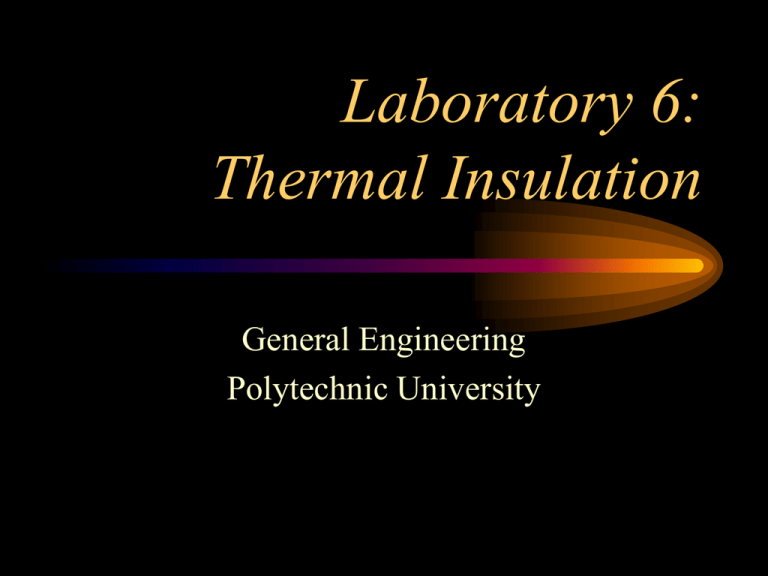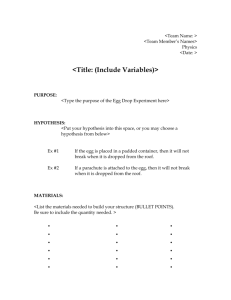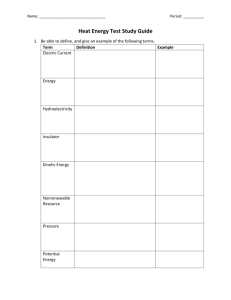Thermal Insulation
advertisement

Laboratory 6: Thermal Insulation General Engineering Polytechnic University Overview • • • • • • • • Objective Heat Equilibrium Heat Transfer Conduction Convection Radiation Thermal Insulation • • • • • • • • Materials for Lab Problem Statement Guidelines Procedure Written Assignment Written Topics Recitation Topics Closing Objectives • Understand the concept of heat as a form of energy • Learn how heat moves to different objects • Use your new knowledge to create a container that keeps an egg from cooling Heat • Energy transferred from one object to another due to a difference in temperature Equilibrium • The temperature at all points in a system are the same 65o 70 73o 70 70o o 125 70o 25 70o 95 70o 39 70o 90 70o 58 50o 70 70o 80 Heat Transfer • A result of all systems trying to reach equilibrium • Heat always travels from higher to lower temperature • There must be 2 or more substances in contact with each other Direction • Three types of heat transfer of Heat – Conduction – Convection – Radiation Now at Hot Cold equilibrium Conduction • Energy transferred from one solid body to another without passing through a medium q = kA DT DX Iron Aluminum q = heat transfer DT = difference in temperature k = coefficient of DX = length of bar A = cross-sectional area thermal conductivity Convection • Heat is transferred by mass transport of atoms • Typically when heat is transferred from a solid material to a fluid substance (or vice versa) q = hA DT Iron Water Steel q = heat transfer DT = difference in temperature h = coefficient of convection A =cross-sectional area Radiation • Energy is admitted and absorbed by bodies in the form of electromagnetic waves • Can travel through a vacuum q = esAT4 q = heat transfer T = temperature e = constant of emissivity s = Stefan-Boltzman’s constant A = cross-sectional area Thermal Insulation • Prevents a system from quickly reaching equilibrium • Examples: – – – – Clothing Walls of houses Refrigerators Thermos bottles Materials for Lab • • • • • Foam chips Plastic wrap Tape Cardboard Aluminum foil • Thermocouple and wire connectors • Thermal LabVIEW program • DAQ board Problem Statement • Build an insulating container to accept a hard boiled egg that was just removed from the hot water. • The container should aid in reducing the loss of heat from the hot egg. Guidelines • All materials must remain inside the container • No external heat sources may be used • Start LabVIEW program when container cover is closed and egg is inside • The container may not be held or covered during temperature readings • The egg may not be returned to the water (i.e. No “restarts”) Procedure •Pre-Test •Test •Post-Test • Pre-Test – Brainstorm & sketch a suitable container to keep the egg warm – Include a written description of the dimensions and construction materials – Build the container according to the sketch Procedure •Pre-Test •Test •Post-Test • Test – Wait to receive boiled egg from instructor – Attach one end of thermocouple wire to the egg (They must remain in constant contact) – Quickly close the container – Connect thermocouple to pins 1 & 9 on the DAQ Board – Start the LabVIEW program Procedure •Pre-Test •Test •Post-Test • Post-Test – Once the time has finished the LabVIEW program will generate an Excel table – Use data on the table to create an Excel graph of Temperature vs. Time – Print out the graph and table – Present the Excel data to your instructor for his/her initials Written Assignment • Full Team Report (one report per team) • Use the guidelines on page 5 for help • Include original sketches with instructor’s initials • Include Excel table and graph • Include the topics found on the next slide • Remember to create a title page Written Topics • Address each of the following topics and place them in the proper sections of report – Describe the guidelines for this lab – Give reasons for your design – Find the slope of the last 5 minutes of the graph. Interpret how the slope and the graph describes the performance of your container – Why are some materials better than others for the purpose of the container? – What factors would affect the readings you recorded? – Describe how you would improve your container if you were to rebuild it Recitation Topics • Discuss the strategy employed by the team in the development of the design • Discuss the choice of materials and quantities used. Were some materials better than others? • Would this lab be a good competition? Why or why not? Closing • • • • The egg is VERY hot, do not burn yourself Clean up your workstation when finished Throw the egg in the garbage after the lab You may keep the cup for recitation, otherwise dispose of it properly





